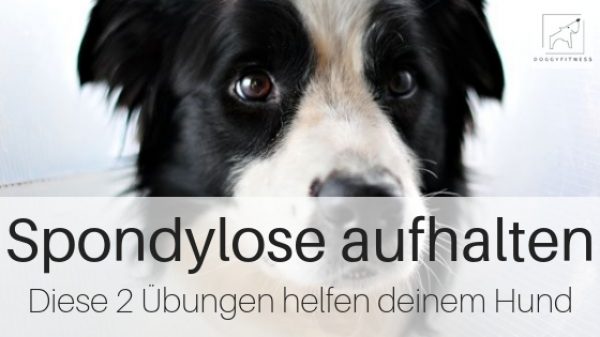Your dog has spondylosis and you want to get active?
What spondylosis means for your dog was the topic of my last post. As promised, in this post I’ll show you two exercises that will help your dog stop the progression of spondylosis; they exercise the muscles, flexibility and coordination.
Spondylosis exercises: 1. stretching the back
And this is how it works:
Your dog is standing on a firm and level surface. You stand over your dog (slightly level with his hips) and you look in the same direction. Then, slowly guide a treat from your dog’s nose in an arc toward your knee. To get the treat, your dog must bend towards your knee. In doing so, he must not leave his basic position. Hold this position for about 3 seconds. Then return the treat until your dog is back in the starting position. Now you give him the treat. Your dog may still be a little stiff in the back at the beginning of the training. It’s not that you go straight into maximum flexion, but slowly increase the flexion. As your dog can do it without difficulty. You should definitely not help it by pressing on its head, you could cause it pain.

How often and what is the effect?
I recommend you start training once a day with 3 reps per side. You can increase the exercise by having your dog bend further and you increase the number of repetitions.
With the exercise you stretch the muscles of the neck and back, keep them elastic and increase the mobility of your dog. In addition, you train coordination and balance.
Spondylosis exercises: 2. the weight shift front-back
And this is how it works:
You kneel in front of your dog and have your dog stand on a rise with his front legs. The elevation can be a step, a curb, books, or a low tree stump. The elevation should be at about the level of his wrist so that your dog can keep the weight shift stable. As a result, he initially shifts his weight to his hind legs and lower back. Now take a treat and bring it a little forward in front of your dog’s nose, so that your dog stretches his neck. If you work with, for example, the nose touch, you can also use this. He now shifts his weight to the front legs and exercises the muscles of the front legs and shoulders. The hind legs remain in their original position. You hold this position for about 3 seconds. Then you give him the treat.

The second step
Now, from the position, pass a second treat over your dog’s head so that he puts his head up. He will follow your hand and shift weight to his hind legs and lower back. You will also remain in this position for about 3 seconds before you give him the treat.

How often and what is the effect?
I recommend you do 3 forward and backward reps once a day to start. You can increase this exercise by letting your dog stay in the position longer and increasing the number of repetitions.
This exercise is ideal for spondylosis, because you train a lot of muscles of your dog and at the same time his coordination and balance.
Always consider your dog’s daily form during your training sessions. Even your dog is not in the same good mood and performance every day.
Let’s go! Now it’s your turn! Have fun training with your dog! You have questions about the exercises? I’ll be happy to answer them for you!
You liked the exercises? You can find them including video instructions and many more exercises in my Backfit Online Course. Perfect for you if your dog has back problems. HERE YOU CAN FIND MORE INFOS ABOUT THE COURSE
Your Tina Spondylosis Exercises Spondylosis Exercises Spondylosis Exercises Spondylosis Exercises Spondylosis Exercises
Dieser Beitrag ist auch verfügbar auf:
Français (French)
Deutsch (German)
Español (Spanish)
















